Nonprofit Spotlight: ECO-Vrindaban’s Cow Sanctuary
Five years ago I became a vegetarian for health and compassion reason. “I want to hug them, not eat them.” is how I feel. But before I go any further, I’m not here to try and convince you to become on or to judge/alienate any carnivore readers out there. (I live with one!)
While in West Virginia, I got to spend some time up-close and personal with these gentle giants, and learn about the local cow sanctuary, ECO-V. I wholeheartedly support animal rights, and I am happy to share some good work being done on behalf of these beautiful creatures.
According to the website, ECOV (Earth Cows Opportunities and Villages) is a 501(c)3 nonprofit dedicated to cow protection, local production of food, sustainable housing, alternative energy production and energy conservation. Cow protection includes not sending cows to slaughterhouses and letting them live out their lives until a natural death.
Regardless of dietary preference or philosophy, I think we can all agree that factory-farming slaughterhouses are just the worst.The West Virginia location is the first of many small villages ECO-V wants to build around an agrarian, spiritual lifestyle based on the mission of plain living, high thinking, and close connections to Mother Earth in a sustainable way.
We took a walking tour of the barns and pastures, and since we had two kids with us, we mainly visited the oldie ‘slowie’ cows. They were just straight up chilling, living out the rest of their days in peace. They were all so gentle! The bulls are kept behind closed gates for everyone’s safety, but the cows have more freedom to roam around.
The idea is really neat, but there is a lot of room for improvement and a lot of work to be done. ECO-V accepts financial donations but the nonprofit also invites folks who want to help spend weekends or vacations helping out, hand-on. That’s the difference-maker, right there. Not just for the organization, but also for those volunteering.
Their work with cows is year-round, but there are numerous other projects in the works from March until December. From planting trees and maintaining them, to building fences, garden spaces and low impact construction projects, there are plenty of nature-related activities for volunteers.
Have you ever gotten your hand dirty with soil?
Helped build or care for something?
It is life-changing.
Visit their website for more information.
You can read the original blog post via this link.
New Vrindaban’s 24 Hour Kirtan to Transport Partipants to Vrindavana Dhama
By Madhava Smullen
The ninth annual 24 Hour Kirtan festival in New Vrindaban, West Virginia is set to give North American participants the experience of the 24 Hour Kirtan that ns 365 days a year in the original Vrindavana Dhama, India without having to travel thousands of miles.
Around 600 devotees from all over the U.S. and Canada are expected to converge in the beautiful rural community that founder Srila Prabhupada called “a new place of pilgrimage for you Western devotees.” During a 1972 visit he also commented, “This Vrindaban, that Vrindavan, no difference.”
The devotee participants will be joined by two groups of students, one from Cleveland State University and one from Carnegie Mellon University in Pittsburgh, attending for the first time.
Leading up to the festival, Europe-based spiritual teacher Kadamba Kanana Swami will give three morning lectures at Sri Sri Radha-Vrindabanchandra’s temple from Thursday June 18th to Saturday June 20th on the importance of chanting the Holy Name.
There will also be an inauguration kirtan with Kadamba Kanana Swami, Agnideva Das and other senior kirtaniyas on Friday evening from 7 to 10pm at Srila Prabhupada’s Palace of Gold.
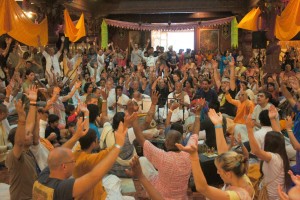
The 24 Hour Kirtan festival proper will then run from 11am on Saturday June 20th to 11am on Sunday June 21st in the temple, which will be decorated with maha-mantra banners, harinama chaddars and lamps.
Participants will sit in a semi-circle facing the Deities. Each of the long list of lead chanters will lead for around one hour, and each will bring their own flavor to an event packed full of variety.
Kadamba Kanana Swami is known for his fired up, rocking kirtans. Agnideva Das – who has been one of the world’s most popular chanters since the 1970s and is now based in Trinidad – steals devotees’ hearts with his classic, soulful style. And Brazilian kirtaniya Amala Kirtan Das, now based in Austin, Texas, brings blissful ragas and astonishing virtuousity on the harmonium.
Meanwhile Ananta Govinda and Acyuta Gopi from New York raise goosebumps with their soul folk kirtan; Mayapuri band member Krishna Kishor injects youthful energy into proceedings; and Gaura Mani Dasi from the Vrindavana, India-based band the Vrajadhus dovetails Bollywood songs in Krishna’s service to create new Hare Krishna tunes that take off like wildfire.
Local New Vrindaban chanters will also lead kirtan, including Rupanuga Das, Abhay Das, Bhaktin Autumn, Ananda Vidya Das, and Lilasuka Dasi.
And youth and children will get a chance too – the boys from ISKCON Alachua’s Summer Trip, aged 12 to 15, will chant for 45 minutes, while a group of children aged 10 and under will chant for half an hour.
“It’s really important for them to have that opportunity to sing at a festival,” says Shri-Ram Poddar, 18, who is organizing the schedule for the festival. “They’ll love it, and it’s just a really good growing experience for them too.”
Shri-Ram is speaking from experience. He first attended the New Vrindaban 24 Hour Kirtan in 2011 when he was 14 and uninterested in kirtan, staying up throughout the night as an experiment. He calls it “the first devotee festival I really enjoyed” and afterwards became passionate about kirtan. Now he’s helping to organize both New Vrindaban’s summer and fall 24 Hour Kirtans, and is inspired to manage other Krishna conscious events too.
While many other kirtan festivals follow the two 12-hour days format, Shri Ram loves New Vrindaban’s because it remains a straight 24-hour event nine years in. This features gets participants intensely focused on the Holy Name, and combined with New Vrindaban’s Brijabasi mood it truly recreates the original Vrindavana 24-Hour Kirtan.
The Vrindavana mood will be particularly evident during the night time hours, when devotees like Amala Harinama and Govinda Das, who both spent time as part of the 24 Hour Kirtan Mandali in Vrindavana under Aindra Das, will chant.
“Govinda Prabhu has been there since at least the early 2000s, and was with Aindra Prabhu for at least ten years, as one of his main mridanga players,” says Shri-Ram. “His kirtan really has Aindra’s mood.”
Most devotees will attend only select parts of the kirtan, taking rest in between in the comfortable motel-style rooms at New Vrindaban’s Palace Lodge (now booked up), in local hotels in Wheeling and Moundsville, or in tents on the ISKCON New Vrindaban grounds.
Every year, however, some brave souls are so inspired that they manage to make it through the entire 24 hours.
The prasadam helps – breakfast on Saturday and Sunday will include kichari, granola, yoghurt, chutney, and a drink. For lunch on Saturday there’ll be fancy rice, dahl, two subjis, macaroni, pakoras, puris, chutney, sweet rice, and mango lassi.
The primetime evening kirtan slots from 6pm to 10 or 11pm on Saturday will be the most packed and energetic, as will Agnideva’s grand finale on Sunday morning, followed by a delicious Sunday Feast at 12:30pm.
Afterwards, participants are usually left hungry for more – more kirtan! “People always say they feel very enlivened and recharged,” says Vrindavana Das, who organizes the festival with assistant coordinator Gauranga Prasad Das. “They always look forward to coming back again.”
And New Vrindaban has what they’re looking for. A fall 24 Hour Kirtan is coming up on October 31st and November 1st, during the sacred month of Kartik – which, of course is one of Vrindavana, India’s most famous festivals.
With a more sweet, mellow mood, devotees will get to offer candles to New Vrindaban’s beautiful Deities, and once again get the Vrindavana Dhama experience without having to travel to India.
ECO-Vrindaban Board Meeting Minutes 05/16/2015
ECO-Vrindaban Board Meeting Minutes 05/16/2015
Mission Statement: ECO-Vrindaban promotes Simple Living, Cow Protection, Engaging Oxen, Local Agriculture, and above all, Loving Krishna, as envisioned by Srila Prabhupada, the Founder-Acharya of ISKCON New Vrindaban.
Participating Directors: Bhima, Chaitanya Mangala, Madhava Gosh, and Ranaka.
Participating Advisors: Sri Tulasi Manjari, Radha-Krishna (partial attendance)
Participating Managers: Mukunda
Recording Secretary: Jordanna
1. Review Staff Commitments/Work Loads
Currently, ECO-V is short-staffed. It was discussed that the Board should be careful not to overload any particular staff member and at times we may have to decline new projects to ensure this does not happen.
2. Mukunda’s Relocation
Mukunda reported that he plans to arrive in New Vrindaban by Monday 05/18/2015.
3. Garden and Ox Training Manager Search
Mukunda has taken the lead on this project and received a few applications already. He prepared some interview questions. The article regarding the search was posted this past week on the ISKCON News website.
4. Prabhupada House Renovation Update
Some more work is still needed on the house in order for it to be inhabitable.
WHEREAS: The ECO-V Board wishes to provide temporary housing for an ECO-V manager.
RESOLVED: The Board authorizes up to $12,500 towards the Prabhupada House renovations.
5. Sponsorship for Educational Courses
At this time, the ECO-V Board will only consider sponsoring people directly engaged by either ECO-V or INV.
6. Prabhupada’s Palace Rose Garden Consultant & Other Expenses
The original $15K allocated for this project has been spent. ISKCON New Vrindaban needs an additional $10K to complete the transition to an organic garden. Mukunda and Ranaka will speak to Gopa and this item will be re-addressed at the next ECO-V meeting.
7. ECO-V Brickyard Building Restoration
The dry storage bins have been installed and the old equipment has been removed. It still requires some painting and finish work.
8. ECO-V Logo, Brochure & Posters
The logo was completed November 2014. The brochure still requires a project leader. The “Prabhupada’s Vision: Our Mission” posters were recently posted at Radha Vrindaban Chandra’s temple. One is in the prasadam hall and another outside the entrance to the temple room. 350 small posters have been printed for distribution to pilgrims throughout the summer season. In the next six months, Chaitanya Mangala plans to design a poster specific to ECO-V’s mission.
Prabhupada’s Family Bonds At 15th Festival of Inspiration in New Vrindaban
By Madhava Smullen
Six hundred devotees from all over North America may have attended the 15th anniversary of the Festival of Inspiration at New Vrindaban, West Virginia over the May Mother’s Day Weekend.
But every single one this reporter spoke to described it as having an intimate, comfortable family mood.
“We were just like good friends spending quality time with each other in a holy place,” says participant Purnamasi Dasi, who hails from Toronto. “And with so many Prabhupada disciples there, there was this powerful sense that Prabhupada is the spiritual father of all of us, and we were just there to be part of his family.”
Launched in 2000, Festival of Inspiration kicked off the “spiritual retreat holiday” template that is so common throughout ISKCON today, and with its packed roster of seminars on a broad range of topics, it remains one of the most popular and unique.
Each day of the three-day festival, from May 8th to 10th, began with the traditional temple morning program including a special hour-and-a-half long Srimad-Bhagavatam class by three distinguished speakers.
Ravindra Svarupa Dasa and Jayadvaita Swami gave scholarly and incisive talks on Friday and Saturday, while Urmila Dasi’s Mother’s Day class connected every stage of a mother’s life to Krishna.
“For example, she said that Krishna nourishes and sustains us, giving us food, water and air even though we don’t recognize He’s there, just like the baby in the mother’s womb,” says participant Haripriya Dasi, a second generation devotee. “It was incredible. It made me realize how every aspect of our lives can be connected to Krishna.”
Each day then continued with four sessions of seminars, each session containing two to three concurrent seminars that partipants could choose from, for a total of sixteen.
ISKCON Communication Minister Anuttama Dasa’s Appreciating Vaishnavas: The First Step in Devotee Care was one standout.
“At one point he had us all stand up, approach each other with folded hands and express our appreciation for each other’s good qualities,” says Haripriya. “It was life changing.”
Elsewhere Varshana Swami’s “Ox Power, Dharma and the Golden Age” on getting closer to nature and the simple life was all the more inspiring because the New Vrindaban resident lives what he preaches. Jayadvaita Swami’s “Anything Goes: Questions and Answers About Krishna Consciousness” made short work of any doubt or query.
And Deena Bandhu’s Braja Lila seminar took devotees through the holy places of Vrindavana, India – followed by a Friday evening “Govardhana Parikrama” in which he physically led everyone on a tour of recreated holy places from Lord Krishna’s pastimes along with his delightfully told stories.
Other seminars included “Krishna Yoga: Be Fit to Serve Krishna” by Gauranataraj Dasa; “Improving Vaishnava Relationships” by Kalakantha Dasa; “Gaudiya Vaishnavism: The Perfect Balance of Head and Heart” by Dravida Dasa; “Prabhupada is With Us” by Gurudas, and more.
On Saturday evening, no less than fifty Srila Prabhupada disciples gathered in ISKCON New Vrindaban’s temple room – decorated with strings of balloons for the Festival’s 15th anniversary – to share their memories of their beloved guru.
The guest of honor was Sally Agarwal, the lady who sponsored Srila Prabhupada’s passage to America along with her husband Gopal and took him into her home in Butler, Pennsylvania.
Sweet, heartfelt, loving and effortlessly funny, her talk was described by many as the high point of the Festival. She spoke honestly about how at first she was afraid to have him stay in her house; how he took “about seven baths a day;” and then how she cried when he left because she was afraid for him as he ventured into New York alone.
“But I guess he did alright,” she said, guesturing around at the palacial temple room.
Other devotees like Malati Dasi, Gurudas, Jayadvaita Swami, Bhaktimarga Swami, Navayogendra Swami, Agnideva Dasa, Ravindra Svarupa Dasa, Sudamani Dasi, Chintamani Dasi, Gopalasyapriya Dasi, Jayasri Dasi and many more all then shared their memories of Prabhupada – commenting on how merciful, forgiving, and personal he was with each devotee; how he understood their hearts and gave them what they needed.
Throughout all these seminars, a Kids’ Camp run by longtime New Vrindaban teacher Lilasuka Dasi and ISKCON New Vrindaban Board member Ananga Manjari Dasi engaged kids aged 4 to 15 so that their parents could freely attend the program.
“With kirtan, storytelling, facepainting, and arts and crafts, they had a great time!” says Festival coordinator Gauranga Prasad Dasa.
Meanwhile three sumptuous prasadam meals a day kept energy levels up and devotees feeling cared for. Served in a giant white tent on New Vrindaban’s bright green lawns, and honored at picnic tables against a backdrop of rolling hills, they were prepared by skilled devotional chefs like Shanka Das, Brihat Kirtan Das, and Radha Dasi.
Breakfasts had a choice of Granola with yoghurt and fruit, or kichari or upma with chutney, along with chai. Lunch included koftas, samosas, puris, halava and healthier options like mint rice, cucumber raita, and green bean and brussel sprout subji, along with mango lassi. And dinner featured options like bread, corn soup, lasagna, apple crepes and tea or hot milk.
During the evenings, devotees socialized or attended kirtans with such kirtan legends as Agnideva Dasa, Havi Dasa, and Karanamrita Dasi.
On Sunday morning, after Urmila Dasi’s Mother’s Day themed Bhagavatam class, devotees surprised her with a huge five by three foot Mother’s Day cake for her 60th birthday. Hundreds of devotees chanted “Happy birthday” in unison to the accompaniment of Ekalavya Dasa’s trumpet – just one of the many delightful moments of Festival of Inspiration’s 15th anniversary.
After a short day of seminars, devotees rushed to grab seats in the Community Hall for the festival’s grande finale of spiritual entertainment at 12:30pm. First off, Bhaktimarga Swami’s play “Blue Mystic,” about Lord Krishna’s childhood pastimes killing demons in Vrindavana, gripped the audience. The cast of a dozen actors and puppeteers delivered knockout performances, expressive dance, and giant demons including a moving Aghasura with fearsome glowing red eyes.
Professional New York comic Yadhunath Das with Krishna Das and Bhaktin Megan followed with several pieces. In one skit, cops grilled a criminal in ISKCON vernacular, pushing him to finally admit, “I did it! I was the one who wasn’t sitting properly!” In another, Yadunath recited a poem about someone who is inspired to chant by eating prasadam in the zany poetry style of Dr. Seuss. And in another, he switched tacks to deliver an extremely moving monologue about devotee care that moved many to tears.
Everyone then tucked into a feast that had to be tasted to be believed, with rice, dahl, eggplant subji, matar paneer, puris, kachoris, pineapple chutney, gulabjamuns, mango sweet rice, and strawberry lemonade.
“The prasadam was excellent, the entertainment was first class, and it was just wonderful meeting with all the devotees at Festival of Inspiration,” said Urmila Dasi after attending.
“That’s the beauty of the festival – that you get to meet old friends and make new ones,” added early ISKCON pioneer Gurudas. “It had a wonderfully intimate feeling. Because our spiritual family really is a wonderful family.”
March Palace Sangam Takes A Look at Why and How the Hare Krishna Movement Came to America

Sankirtan prabhu gives a presentation to guests at Radha Vrindaban Chandra’s Temple in New Vrindaban.
By Madhava Smullen
On March 14th, ISKCON New Vrindaban and Eco-Vrindaban board members as well as community residents wrapped up a busy first day of spring board meetings by spending time with the person whose vision lights the way ahead for them – Srila Prabhupada.
Having bonded and inspired New Vrindaban residents for the past two years, the regular “Prabhupada Sangam” organized by Kripamaya Das and his wife Krsna Bhava Dasi in the gorgeous temple room of Prabhupada’s Palace was a perfect cap to the day.
This particular Sangam featured a 130-picture slideshow entitled “Voyage to the West: Why and How the Hare Krishna Movement Came to America” by professional storyteller Sankirtan Das. Sankirtan plans on showing it in schools and universities around the country in honor of the 50th anniversary of Srila Prabhupada’s journey from India to the West.
After a melodic bhajan led by Bhakta Will to set the mood, the gilded gold and marble temple room fell into darkness and devotees leaned forward eagerly to see the show.
As images of Sri Chaitanya Mahaprabhu filled the presentation screen, Sankirtan’s clear, dramatic voice narrated the history of Mahaprabhu’s sankirtan movement, which caused a spiritual revolution in 16th century West Bengal.
Sankirtan then described how 500 years later, Srila Prabhupada took the cargo ship Jaladuta to the Western World, bringing with him only seven dollars in rupees, a case of books, and Sri Chaitanya’s simple message – love God, or Krishna, who is our dearmost friend.
Setting the scene for Prabhupada’s arrival, Sankirtan described how the hippy movement of 1960s America was the reaction of dissatisfied youth to the directions their elders had taken, such as rampant consumerism and the Vietnam War.
Ironically, Srila Prabhupada, at seventy years old, was just the person they were looking for. He was “the downtown Swami,” accessible to everyone. And he had a message that could change the world.
In 1966, when many newspapers including the New York Times ran headlines about his first chanting party at Tompkins Square Park, Prabhupada announced, “Now my movement has begun.”
From there Sankirtan described how ISKCON quickly grew, and listed all of Prabhupada’s achievements: how he circled the globe 14 times in 12 years, established 108 temples, wrote 80 books, and left us “a wonderful lifeline in the Hare Krishna mantra.”
Sankirtan also mentioned Srila Prabhupada’s 1976 visit to New Vrindaban, during which Prabhupada stayed for nine days in the house where Sankirtan lives now. “Today,” Sankirtan said, showing a photo of Prabhupada talking on his lawn, “New Vrindaban residents continue to try to realize his vision for the community.”
As the lights came up, New Vrindaban co-GBC Anuttama Das asked everyone to think about ways they could publicly celebrate Prabhupada’s arrival in the West this year, and ISKCON’s 50th anniversary in 2016. One idea, he suggested, was to participate in World Harinama Day on the 50th anniversary of the first Tompkins Square Park Harinama.
Others then shared their experiences of how Srila Prabhupada had impacted their lives.
Professor Burke Rochford, who has studied ISKCON since the 1970s, recalled how when he had just started his research, he hadn’t met Prabhupada, but all the devotees kept talking about him. Rochford couldn’t quite understand their devotion to him until he saw Prabhupada himself.
“I was there in 1975 when he visited Los Angeles,” he said. “And when he got out of the car, there was this explosive energy, and it just hit me, what he meant to people. That event really impressed on me his significance to all the devotees.”
Next Nityodita Das spoke about how before becoming a devotee he was riding a wave of rebellious movements. “I remember I was staying in a teepee, and someone gave me a copy of Prabhupada’s Sri Isopanisad,” he said. “In one fell swoop, just one sentence completely dissipated my attraction to Marxism.”
Finally local Wheelinger Bhakta Trevor shared the perspective of a newcomer who received Prabhupada’s grace through his devotees. “I was born in the area, but moved a lot and only heard about Prabhupada’s Palace in 2009,” he said. “A friend showed me a photo and I was immediately attracted.”
Trevor described how he began to visit New Vrindaban often and asked if he could help out. His story about mistakenly chainsawing up an entire tree that Madhava Gosh Das had asked him to cut just one branch off had the room in stitches.
“Madhava Gosh was very forgiving about the whole thing,” Trevor said. “I figured I couldn’t just show up once and butcher a tree, so I kept coming. What inspired me to stay was the devotees and how loving they are.”
The stories created a warm, sharing mood that continued on as everyone participated in an enthusiastic arati led by Dayavira Das, and finally sat down together to a delicious prasadam feast.
ECO-Vrindaban Board Meeting Minutes 04/19/2015
ECO-Vrindaban Board Meeting Minutes 04/19/2015
Mission Statement: ECO-Vrindaban promotes Simple Living, Cow Protection, Engaging Oxen, Local Agriculture, and above all, Loving Krishna, as envisioned by Srila Prabhupada, the Founder-Acharya of ISKCON New Vrindaban.
Participating Directors: Anuttama, Bhima, Chaitanya Mangala, Kripamaya, and Ranaka.
Participating Advisors: Sri Tulasi Manjari
Participating Managers: Mukunda
Recording secretary: Jordanna
1. Ox Program and Garden Managers Search
The Garden Manager search announcement went out last week and the Ox Program Manager listing will be posted this week. Madhava Smullen will write an article about the positions, as well. There has already been some interest in the Garden Manager position and the Board Members look forward reviewing potential candidates for both roles.
2. Managers’ Housing
Vyasasan reports that the Prabhupada House (formerly known as the Green House) renovations are slated to be completed in about two weeks, in time for Mukunda’s relocation.
3. ECO-V Forest Preservation Policy
There is concern that trees may have been cut down without permission on ECO-V managed land. Kripamaya and Mukunda will look into the issue and make recommendations to the Board.
4. Addition of a Timekeeper to ECO-V Meetings
The ECO-V Board will be adding a Timekeeper to their meetings as a way to make them more concise and efficient. Mukunda prabhu has volunteered to take on this role. He will work with the Board Chair and Secretary to allot a specific amount of time for each agenda item.
5. Village Council
A “Steering Committee” has been organized in order to form a New Vrindaban Village Council, consisting of Ananga Manjari, Advaita, Devala, Jaya Krsna (Gopisa as proxy), Mukunda (Ranaka as proxy), Nityodita and Vyasasan. They will be meeting this Tuesday. Mukunda will begin attending meetings once he is living in New Vrindaban.
6. Flower Garden Crew
Currently Vidya is working in the flower gardens, along with the help of a few volunteers. Jaya Krsna requested additional assistance for this volunteer crew. Mukunda will help with this once he is settled in New Vrindaban.
Steady Improvement Shown Throughout New Vrindaban Departments
By Madhava Smullen
ISKCON New Vrindaban and Eco-Vrindaban’s latest Department Head reports, on March 14th, showed that devotees were continuing to cooperate together with encouraging progress towards crystallizing Srila Prabhupada’s vision.
Co-GBC and MC for the day Anuttama Das introduced the event, explaining that since 2011, INV and ECO-V’s Boards of Directors and their managers and staff have gathered to communicate accomplishments of the past year and plans for the upcoming one.
But two years ago, they decided to make the gatherings open for all New Vrindaban residents and well-wishers to participate in. Sure enough, a sizeable group of residents were present, including longtime resident Varshana Swami, who offered a beautiful invocation that set the mood and intent for the weekend.
New ECO-V chairman Bhima Walker then introduced ECO-V’s department heads, beginning with interim Flower Garden manager Vidya Dasi. Vidya’s plans for the year included maintaining all the flower gardens; giving guests the experience of picking flowers and making garlands for Krishna; and creating an inviting atmosphere by adding benches, garden art and well-designed flower beds to the front of the temple.
Next, Ananda Vidya Das and his wife Lalita Gopi Dasi from Cow Care and Milking described how they get 30 gallons a day from their seven milking cows – enough for all the temple’s needs — and supply the Deity kitchen with butter, ghee, yoghurt and curd. They reported high standards of cow care, announced that two new calves were expected soon, and were glad that the milking barn’s ceiling had been insulated to make winters serving there easier.
Brand new ECO-V Project Manager Mukunda Das, who will be moving to New Vrindaban in May, said that initial teams had already been but together to discuss plans for an eco-village and food processing facility; and that he would be working on eco-friendly housing beginning with one demonstration home.
Bhakta Richard of the Ox Program reported that the three young teams of Isan and Balarama, Hari and Priya, and Manu and Nandi are all making great progress in training with the yoke and learning commands. In addition, oxen moved into the rebuilt Bahulaban ox barn at the end of last year; ox cart designs have been presented by carpenter Vyasasana Das; and a turnstyle that can run a saw or mill with ox power has been acquired.
Gopal’s Garden, the homeschool co-op run by Ruci Dasi, reported a new preschool for two to four-year-olds, a fundraising drive for improving its playground, and input from many members of the community. Proving that it does indeed take a village to raise a child, they teach such subjects as dramatic reading, literature, poetry, Deity worship, kirtan, art, and music. The school also has a charming new logo featuring youthful Krishna playing His flute.
ISKCON New Vrindaban community president Jaya Krishna Das then introduced INV by sharing its new mission statement: “To please Srila Prabhupada by promoting his vision for New Vrindaban through steady development of Simple Living, Holy Pilgrimage, Community Outreach, Spiritual Education, and, above all, Loving Krishna.”
Local brahmachari Bhakta Trevor with Community Outreach was first up for INV. He reported that he maintains regular Harinam Sankirtan and book distribution in Wheeling and Pittsburgh; is starting home programs in Morgantown; and plans to start a Krishna Club at West Virginia University, where students are already chanting. He also holds a weekly kirtan at Wheeling’s new age store The Noble Source, where the owner chants and keeps Prabhupada’s books. He has done all this, he said, through making friends and building loving relationships.
The super-busy Vrindavan Das reported on the three departments he oversees, beginning with Communications, in which he talked about making friendships with locals and students; inviting the Mayor of Wheeling and Moundsville City manager to Festival of Colors and Rathayatra; developing an attractive monthly newsletter; and having regular articles published on ISKCON News, Dandavats, Brijabasi Spirit, and also in the secular media.
In Marketing, Vrindavan outlined plans to launch New Vrindaban’s new website this year, and create an attention-grabbing brochure for the Palace of Gold and New Vrindaban which will be placed in visitors bureaus, local tourist attractions, and hotels. He also plans to place permanent billboards on two major highways to promote the Palace of Gold by mid May this year.
In Festivals, he said he planned to make national events of Nrsimha Chaturdasi and of Srila Prabhupada’s Appearance and Disappearance Days at his Palace. He also talked about plans to hold an early July retreat this year with Bhakti Charu Swami; open Rathayatra at New Vrindaban to the Ohio Valley public; and replicate Prabhupada’s Bhagavat Dharma Discourses. He also hoped to enhance national participation in Kartik, the 24 Hour Kirtans, Festival of Colors, and Festival of Inspiration, which expects a bigger crowd this year with Jayapataka Swami attending.
In an encouraging step towards succession, a father and son team presented next. Guest Lodge manager Gaura Bhakta reduced prices for rooms and cabins, and plans to install lights to guide guests to the Welcome Center at night. He also hopes to increase guest visits during weekdays; and to have four new rooms with attached bathrooms on the ground floor by this year’s Festival of Inspiration.
His father Vasudeva Das plans to keep Govinda’s Restaurant open longer each year, from March 28th to January 2nd, to launch a new webpage for it, and to add new uniforms and name tags for staff. He reported that Govinda’s used only in-house dairy for the past six months, and announced the arrival of new cook Sri Rupa Das from Mumbai; and new menu items such as Indian sweets, Italian lasagna and canelonis, and Mexican items like burritos.
Vasudeva also reported on the Devotee Kitchen, which is working on creating a balanced diet for devotees so that they get proper nutrition. The kitchen will be getting a new altar and a new oven this year. It is also mainly using New Vrindaban protected dairy and has dramatically increased use of locally grown produce.
In Palace Restoration, Gopisa Das has a plan to expand the parking lot of Srila Prabhupada’s Palace from 18 parking spaces to 80, with a bus turnaround. He also plans to complete the outer wall and upper steps this year, with the lower steps and entry railing to follow.
In Facilities, also overseen by Gopisa, the library, third floor residential rooms and hallway from the kitchen to the temple room were renovated, and frozen pipes and radiators fixed. This year, Gopisa plans to upgrade the temple and lodge’s electrical systems, and renovate the lodge bathrooms, restaurant kitchen, temple siding and entry doors, cabin roofs, and swan boat house.
In the Palace Rose Garden, Gopalasyapriya Dasi spoke about her plan to stop using chemical fertilizers and start using more natural methods with the help of Paul Zimmerman of the American Rose Society, who recently did the same for the famous Biltmore Gardens in North Carolina. This, she felt, would attract a lot of people.
Speaking for Varshana Swami, Jaya Krishna reported that the Land Management department is working on the Palace parking lot and improving roads, drainage, and the Govardhana Parikrama path; but that it needs qualified young personnel to replace Maharaja, who is suffering from health problems.
In 2015, Treasurer Laxmi Honest aims to make sure funds for helping devotees through capital improvements and housing are used for those purposes only. She will also provide all department heads with “monthly budget vs actual” reports so that they can understand where they can spend less and more.
A new addition to Congregational Development, Daya Gauranga Das, reported a team of five preachers and a plan to increase fundraising 14% this year. However, he also emphasized that the the focus of congregational development was not taking but giving, by sharing with people a spiritual solution to their problems. He announced that five “Lila Sthalis,” or places of the Lord’s pastimes, would be marked on the community’s Govardhana Parikrama path with dioramas and art, and that Dina Bandhu Das will launch an annual Braj Mandala Parikrama at New Vrindaban this May.
Last but certainly not least came the Deity Department, headed up by Abhinandana Das. This year it created a sustainable and reliable team of pujaris with a family mood of cooperation; maintained punctuality and high cooking standards; and renovated the Deity kitchen and pujari room. In 2015, the pujaris plan to re-launch the Deity sewing room to fix old and torn outfits; extend the dressing room to create more space for the Lord’s outfits; build a new house for Tulasi Devi; and facilitate a second ISKCON Deity Worship Ministry training course.
As the presentations ended, Jaya Krishna, in a generous guesture, offered everyone a bag of Govardhana dust and CDs from his recent Braj Mandala Parikrama in Vrindavana, India.
He also invited all to take a copy of the beautifully designed “Prabhupada’s Vision: Our Mission” poster, saying, “Please take one and put it up on your refrigerator or next to your altar so that we are reminded daily of what Srila Prabhupada wants from us.”
His request reflected how many board members, managers, and New Vrindaban residents left the presentations – newly energized and refocused on Srila Prabhupada’s vision for his first rural community.
ECO-V Seeks Ox Care and Garden Managers in New Vrindaban
By Madhava Smullen
Two unique opportunities have arisen in New Vrindaban, West Virginia, USA.
ECO-Vrindaban, a non-profit organization that promotes Prabhupada’s ideals of simple living, cow protection, engaging oxen, local agriculture, and above all, loving Krishna, is searching for managers for its ox care and garden programs.
Protection of cows and bulls, Prabhupada said, “should be the main business of New Vrindaban.” He taught early residents to respect the cow, who could provide milk for nourishment, as their mother; and the ox, who could pull a plow to till the land, as their father.
There has been a cow protection program at New Vrindaban since 1969. But as with most ISKCON rural communities, the ox training program has not been maintained consistently.
Two years ago, however, ECO-V made a concerted effort to revitalize it. Last year, a dilapidated barn in the Bahulaban area was completely rebuilt, and became a home for oxen.
Three teams of young Brown Swiss oxen – Ishan and Balarama, Priya Darshan and Harichand, and Nandi and Manu are currently at different stages of training with Richard and Chaitanya Bhagavata Das. The oldest now work with yokes, follow commands, and pull logs. The ultimate goal is for them to pull plows in the community’s vegetable gardens, as well as carts of pilgrims, all to demonstrate a simple lifestyle.
To help lead this program, ECO-V seeks an individual passionate about cow protection; physically able to work with oxen; and willing to live in New Vrindaban for this full-time salaried position.
Duties include handling logistics and budgets; being an educational resource for local cowherds; and coordinating ox training volunteer activities. The ideal candidate will be a great team builder and have management or leadership experience, preferably with a non-profit.
“This person will make an important contribution by overseeing the revival of one of Prabhupada’s key instructions for New Vrindaban,” says ECO-V board member Chaitanya Mangala Das.
ECO-V is also looking for a garden manager to develop local agriculture, another key part of Srila Prabhupada’s vision. “These duties are there in New Vrindaban, and we shall have to live there self independently, simply by raising cows, grains, fruits, and flowers,” he wrote in 1969.
There are currently two main community garden spaces in New Vrindaban. One is called the Teaching Garden, a half-acre plot where herbs and flowers for the Deities are grown; the other is the fenced in seven-acre Garden of Seven Gates. In previous years that space has grown sweet potatoes, tomatoes, peppers, green beans, snap peas, quinoa and much, much more.
The new garden manager can look forward to taking on a well-organized program – previous manager Kacey Orr, an experienced local farmer, cleaned up the grounds and facilities, erected hothouses, and established a system for planting perennial and annual vegetables and flowers. The gardens also have an irrigation system and all the tools and equipment required.
The new manager will be working closely with ISKCON New Vrindaban’s Deity, Devotee and Govinda’s Restaurant kitchen managers to supply them with fresh vegetables.
ECO-V is seeking someone experienced and knowledgeable in gardening, passionate about environmental and food production issues, and able to handle the physical work. Once again leadership experience is ideal, as is an ability to maintain positive relationships with community members and guests.
Also a full-time salaried position, duties include handling logistics and budgets, being an educational resource for local gardeners and coordinating volunteer activities.
“It’s a good time to be a part of the New Vrindaban community, because lately there’s been a lot of focus and energy given to revitalize the core instructions Prabhupada gave us,” says Chaitanya Mangala. “And this is a great opportunity to be part of a dynamic team.”
For those interested in either position, please send cover letter, resume and any other inquires to Mukunda Das: coachmarc108@gmail.com
ISKCON Communications Training Course May 16-17 at New Vrindaban
All devotees, including leaders, are invited to attend the upcoming ISKCON Communications Training Course in New Vrindaban Sat. & Sun. May 16 & 17, 2015.
Anuttama das will be the very entertaining and experienced facilitator.
You will learn such valuable things as:
- mastering key skills including listening, speaking & understanding the needs of others
- improving communications through interactive training
- enhancing our ability to spread Krsna consciousness
- building strong relationships amongst devotees
The two day schedule is:
SATURDAY MAY 16
10:00 am- 1:00 pm training session with break included
1:30 pm lunch
2:30- 5:30 pm training session with break included
6:30- 8:30 pm special evening session on devotee relationships
SUNDAY MAY 17
9:30 am- 12:30 pm training session with break included
12:45 – 2:00 pm training session
2:00 pm sunday love feast
AFTER FEAST possible training session
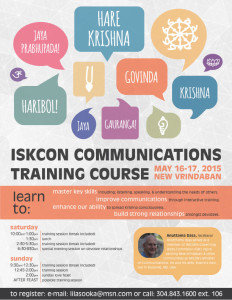
The course registration is free and sumptuous prasadam is also provided.
(If anyone is inspired to give a donation, it will be accepted of course!)
Please reply to iskconnv@gmail.com if you will be attending, so we can make plans for serving everyone nicely.
Looking forward to serving you,
The New Vrindaban Communications Team
College Students Visit New Vrindaban and More
It’s been a hectic six weeks for Sankirtana Das, New Vrindaban’s resident storyteller and college liaison. During this time, he hosted a half dozen student groups visiting the community. Sankirtana Das explained, “One of the student groups who visited New Vrindaban were from a Christian College here in West Virginia. I thought they would be a little skeptical, but I was delighted when they danced with such enthusiasm during the arati. All the devotees at the kirtana did a great job of engaging them in the service. ” (read student comments below).
Sankirtana also traveled to two colleges to present “Why & How the Hare Krishna Movement Came to America,” his media presentation of 130 pictures commemorating the 50th anniversary of Srila Prabhupada’s arrival in America. “The program was well received,” Sankirtana said, “and more colleges have scheduled the program for the fall.”
Another trip took him and his wife Ruci dd to Shepherdstown, WV. There, Sankirtana offered a program of Vedic Stories (katha) for an audience of almost 70. Afterwards, the audience (many affiliated with the college in town) enjoyed cookies made at Govinda’s, our vegetarian restaurant, and received Palace of Gold brochures. Ruci was surprised when about a half dozen people told her that they had already been to the Palace. “That’s almost ten per cent of the audience,” she said, “and others promised to visit.” The town is the oldest in West Virginia and home to Shepherdstown University. From there, Sankirtana and his wife journeyed to the Philadelphia ISKCON Temple where he did an evening program for a group of thirty.
Besides all this, Sankirtana Das is working on writing and researching material for a new book, as well recording and editing his soon to be released audio CD on stories of Hanuman. For info about Sankirtana’s award-winning book Mahabharata: The Eternal Quest see www.Mahabharata-Project.com
*****
College Student Experiences of New Vrindaban
Overall I really enjoyed the opportunity to visit the Hare Krishna center and see how Hindus live their lives. It was really neat that they welcomed us so energetically and that they were truly happy to show and tell us about their religion and culture. The people at the Islam and Jewish centers weren’t nearly as welcoming as the Hindus were.
I’ve never known much about the Hindu religion until this class and this experience, but the extravagant artwork at the palace was definitely my favorite part. Something we talked about in class was that Hindus claim to live simple, non extravagant lives, yet they have this huge golden palace in their community, and they put so much time and effort into their shrines to the gods. While I understand how this could confuse people, I also kind of understand it. Worshipping their gods is the most important thing to Hindus and they believe the best way to do this is to dedicate shrines and temples that are heavily decorated to show their love and devotion.
A really interesting thing I find about this religion is all of the interesting stories and tales they have as their history. The stories remind me of Greek and Roman mythology and it was really interesting to listen to some of them as we were getting a tour of the Palace. I would really like to read some of the accounts in the Bhagavad Gita and learn more about what Hindus think really happened in history. I respect their religion because they are open to all other religions as well. They don’t discriminate or hate like many other religions do and that’s a rare quality for a religion.
During their worship service it was intriguing to watch the members and how they participate. There was a lot of dancing and chanting for a solid thirty minutes; it almost looked like a workout. They were really passionate and devoted in their service and I almost felt like I was at some type of party or ceremony. This type of worship, to me, is much more interesting and fun than sitting down and listening to someone talk.
I enjoyed this visit to the Hare Krishna center and I would definitely say that it was my favorite experience of the three trips we went on. It’s something that I would like to take my younger brother and sister to as a cultural learning experience and as just something fun to experience on the weekend.
This was by far my favorite trip that the class has taken so far. The Hindu community is beautiful and very interesting. From the architecture of the buildings to the homes of those who live in the community every single part was beautiful. The spirituality that was present was very strong and exciting. Each follower was very welcoming and passionate about their religion.
The thing that caught my eye was the Palace. It is amazing to think that it was built by people who did not have any knowledge about construction. The detail that was put into the building was phenomenal. I knew that the Palace was designed to be a home for Prabhupada, but I did not realize how practical the structure was. It is so big and extravagant on the outside but so practical on the inside, which is what amazed me the most. The rooms were rather small inside I almost felt as if I was in an apartment instead of a palace. I really enjoyed the tour of the Palace it was as beautiful as I had imagined it to be.
I enjoyed the worship service. I was not sure what to expect when I walked into the temple. I kept thinking about how we had to take off our shoes at the Mosque and how this custom made Hinduism similar to Islam. The temple was absolutely beautiful, the altars were amazing and very interesting. The amount of detail that went into all of the altars was mind blowing and I do not believe I have ever seen anything like it. I found it very interesting that the altars were actually changed for seasons and events. It is similar to how my home church changes the decorations on the altar for the season or holidays, so it was cool to have that comparison.
The service was very interesting and exciting, I had never experienced anything quite like it. The atmosphere of the ceremony was very intense and inviting at the same time, and it seemed to keep me engaged and interested. When I think of worship I think of sitting and hearing a lesson or prayer, I most definitely do not think about dancing. When everyone started dancing, jumping, and yelling I was caught off guard. I knew that the ceremony was definitely different and there would be a lot of dancing and chanting but I was not ready for how intense it was. Once I relaxed and started participating in the service I understood why it was so fulfilling to Hindus. It was exciting and fun to be dancing with everyone while worshiping. Of course I was not worshiping Hare Krishna, but as others were I could see how passionate they were. The ways that they were dancing or jumping showed how much they love their religion and how thankful they are for Hare Krishna.
After experiencing Hinduism first hand I have a deeper understanding for the religion. I always thought it was the typical worshipping of idols and cows, but it is most definitely more than that. It is a true religion just like Christianity. Each Hindu strongly believes in Hare Krishna just like every Christian believes in Jesus Christ. Hinduism is a very welcoming, loving, and fun religion that I believe is misunderstood.
Of all the places we have visited so far, I think that the Hare Krishna Center in New Vrindaban was the most entertaining. Their buildings were exquisite and their service was energetic. The people were all incredibly friendly, especially the gentleman giving us the tour. I liked hearing Hinduism explained by someone who actively practices the religion. I think it helped make it a little less confusing. There were several wax figures of the great Hindu teacher. This particular branch of Hindus follows Prabhupada as their guide and example, and they specifically worship Krishna as their personal god.
I would like to visit the Hare Krishna Center again sometime, and hopefully gain even more insight about Hinduism. After our tour guide’s explanation of various concepts, it was starting to make a little more sense, but there is still a lot about Hinduism that is different than Christianity and even American culture. It was a lovely and interesting experience, although a bit strange.
Our Major World Religions class went to visit the Palace of Gold, a Hindu center in Moundsville, WV. Seeing as the last visit to the mosque and the previous visit to the synagogue had gone really well, I looked forward to our visit to the Hindu center. At the temple, we were invited to participate with the Hindu believers as they worshipped their gods. Some people found this uncomfortable, while others viewed it as more of a cultural experience. Sacrifices of food were offered to the idols. That day was very chilly, and I noticed that while there were no heaters to keep the people warm, there were heaters in each of the idols’ rooms. The people at the Hindu temple were extremely friendly. As they worshipped, the Hindu believers recited the Maha Mantra: Hare Krishna, Hare Krishna, Krishna Krishna, Hare Hare, Hare Rama, Hare Rama, Rama Rama, Hare Hare. Throughout the service they chanted this in a sing-songy manner, while dancing. There were also people playing the drums and other instruments to accompany the singing.
I enjoyed the dancing during the service. They pull individuals, who were standing on the side, into the center of the floor. Though some did not participate, I decided to join in. It was actually really fun! I also wafted the incense over my head. After a group of girl students had formed a large enough circle, the older Hindu women brought some of their little girls into the center of our circle, the younger girls creating a dance circle of their own within ours. Even though I do not believe in Hinduism, I still admire their spirit as they praised their gods. I could really tell that they were enthusiastic about being there and excited to have us joining them.
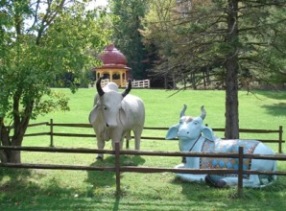
Welcome to Brijabasi Spirit
Thank you for taking the time to visit the New Vrindaban community blog. Think of visiting our blog as making a virtual pilgrimage.
Hare Krishna Hare KrishnaKrishna Krishna Hare Hare
Hare Rama Hare Rama
Rama Rama Hare Hare
"May cows stay in front of me; may cows stay behind me; may cows stay on both sides of me. May I always reside in the midst of cows."
Hari Bhakti-vilas 16.252

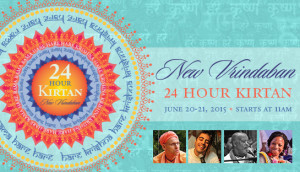
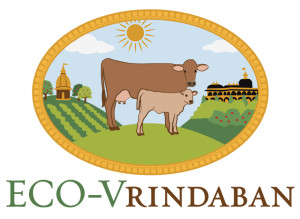
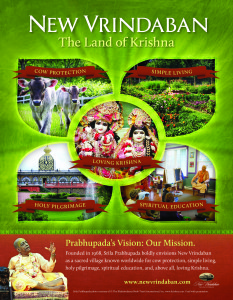







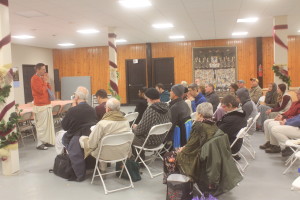
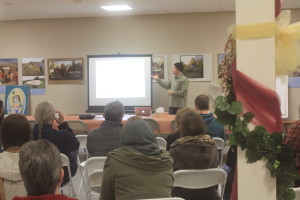
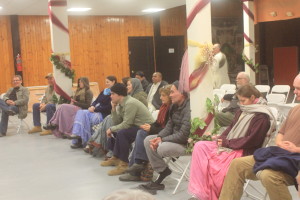

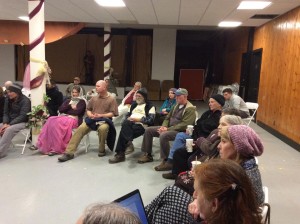
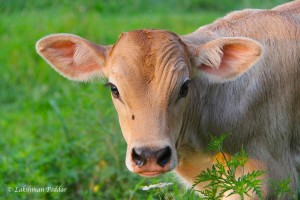


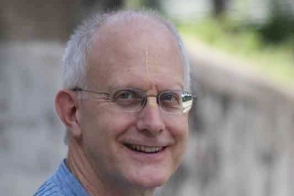





Recent Comments